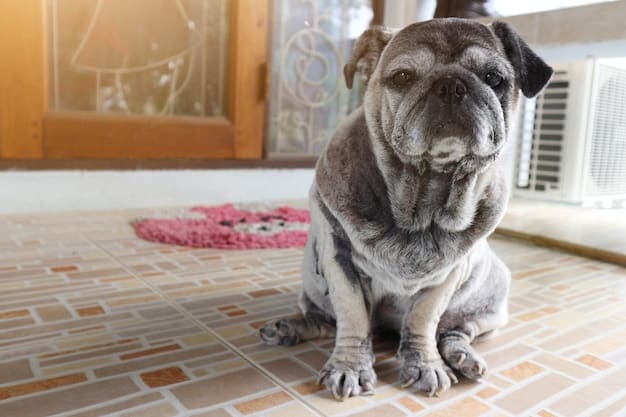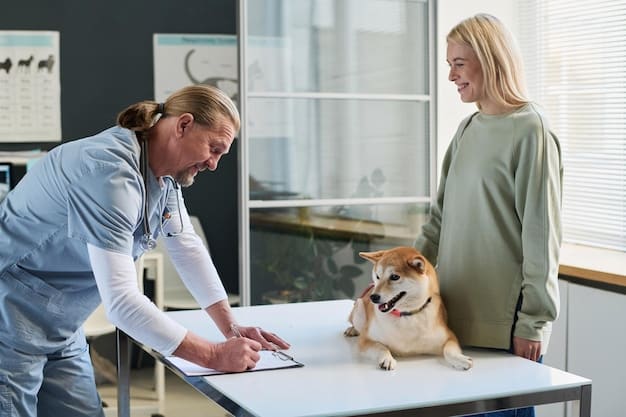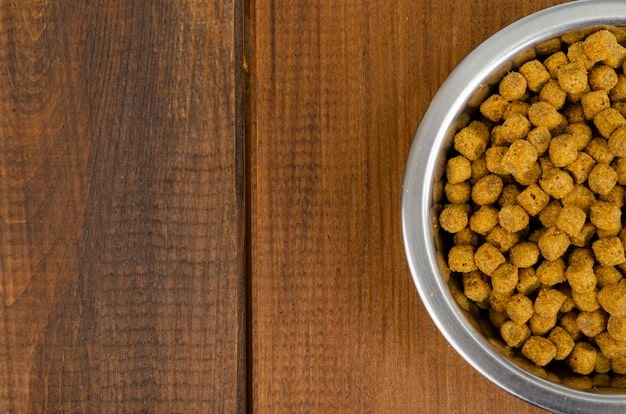Canine Cognitive Dysfunction: Latest Training Strategies for Symptoms

Canine Cognitive Dysfunction (CCD), akin to Alzheimer’s in humans, can be managed through various training strategies that help stimulate mental activity, maintain routine, and improve the quality of life for affected dogs.
As our beloved canine companions age, they may experience cognitive decline, similar to Alzheimer’s in humans. The Latest on Canine Cognitive Dysfunction: Training Strategies to Manage Symptoms focuses on effective methods to help manage the signs and symptoms of this condition, ensuring a better quality of life for your furry friend.
Understanding Canine Cognitive Dysfunction
Canine Cognitive Dysfunction (CCD) is a neurodegenerative condition affecting older dogs, leading to a decline in cognitive abilities. Recognizing the signs of CCD early is crucial for implementing management strategies.
What is Canine Cognitive Dysfunction?
CCD is often referred to as doggy dementia or canine Alzheimer’s. It involves the gradual deterioration of cognitive functions, such as memory, learning, and awareness.
Common Signs and Symptoms
Keep an eye out for these indicators that may suggest your dog is experiencing cognitive decline:
- Disorientation and confusion: Getting lost in familiar places.
- Changes in social interactions: Reduced interest in playing or interacting with family members.
- Sleep-wake cycle disturbances: Increased restlessness at night or sleeping more during the day.
- House soiling: Accidents inside, even if previously house-trained.
A veterinarian can properly diagnose CCD through behavioral assessments and ruling out other medical conditions.

The Role of Training in Managing CCD
While there is no cure for CCD, specific training approaches can help manage symptoms and improve a dog’s overall well-being. These strategies focus on mental stimulation, maintaining routine, and promoting a sense of security.
Mental Stimulation Exercises
Engaging your dog’s mind can help slow down cognitive decline. Simple activities tailored to their abilities can make a big difference.
- Puzzle toys: Provide interactive toys that require problem-solving skills.
- New tricks: Teach simple, new commands or tricks.
- Scent work: Hide treats and encourage your dog to find them using their sense of smell.
Vary the exercises to keep your dog interested and prevent boredom.
Maintaining Routine and Familiarity
Dogs with CCD benefit from a consistent daily routine and a familiar environment. Predictability helps reduce anxiety and confusion.
Stick to a regular schedule for feeding, walks, and playtime. Keep furniture and belongings in the same place to avoid disorientation. Introduce changes gradually and minimize disruptions.
Modifying the Environment for Dogs with CCD
Making changes to your home environment can improve safety and comfort for dogs with CCD. These modifications are designed to address common challenges such as disorientation, mobility issues, and anxiety.
Creating Safe Zones
Designate quiet, safe spaces for your dog where they can retreat and feel secure. These areas should be easily accessible and free from hazards.
Improving Accessibility
Consider these adjustments to help your dog navigate your home more easily:
- Ramps or steps: Provide assistance for getting on and off furniture or navigating stairs.
- Non-slip surfaces: Use rugs or mats to prevent slips and falls on smooth floors.
- Night lights: Dim lighting can help reduce disorientation and anxiety during the night.
Regular vet checkups are essential to monitor your dog’s health and adjust the environment accordingly.
Nutritional Support for Cognitive Health
A balanced diet can play a significant role in supporting cognitive function and overall health in senior dogs with CCD. Certain nutrients are known to benefit brain health.

Key Nutrients for Brain Health
Consider incorporating these nutrients into your dog’s diet:
Omega-3 Fatty Acids: These support brain cell structure and function.
Antioxidants: Vitamins E and C, selenium, and carotenoids protect brain cells from oxidative damage.
MCTs (Medium Chain Triglycerides): These can provide an alternative energy source for the brain.
Always consult with your veterinarian before making significant changes to your dog’s diet.
Supplements and Prescription Diets
There are commercially available dog foods and supplements specifically formulated to support cognitive function. Prescription diets often contain a blend of key nutrients designed to address the needs of senior dogs with CCD.
Medications and Veterinary Interventions
In addition to training and environmental modifications, medications may be prescribed by your vet to manage the symptoms of CCD. These medications aim to improve cognitive function and reduce anxiety.
Commonly Prescribed Medications
Selegiline is a medication commonly used to treat CCD in dogs. It works by increasing dopamine levels in the brain, which can improve cognitive function and alertness.
Consulting with Your Veterinarian
Regular veterinary checkups are crucial for monitoring the effectiveness of medications and making adjustments as needed. Your vet can also help you manage any potential side effects.
Continuous monitoring and adjustments allow for optimal management of CCD symptoms.
Emotional Support and Caregiver Well-being
Caring for a dog with CCD can be emotionally challenging for pet owners. It’s essential to prioritize your own well-being while providing the best possible care for your furry friend. Understanding and managing caregiver stress is important for both you and your dog.
Seeking Support
Joining support groups or online forums can connect you with other pet owners facing similar challenges. Sharing experiences and tips can provide valuable emotional support.
Managing Stress and Self-Care
Make time for activities that help you relax and recharge. Whether it’s spending time in nature, practicing mindfulness, or pursuing hobbies, prioritizing self-care is crucial for maintaining your well-being.
Self-care enhances your ability to provide compassionate care for your pet.
| Key Point | Brief Description |
|---|---|
| 🧠 Mental Stimulation | Engage in puzzle toys, new tricks, and scent work. |
| 🏡 Environmental Mods | Create safe zones, improve accessibility with ramps, use night lights. |
| 🍎 Nutritional Support | Provide omega-3s, antioxidants, and MCTs. |
| 💊 Veterinary Care | Consult vet for medications and regular checkups. |
Frequently Asked Questions
▼
Early signs include disorientation, changes in social interactions, sleep disturbances, and house soiling despite previous training. Noticing these early is essential for timely intervention.
▼
Puzzle toys provide mental stimulation, which helps keep the brain active and can slow down the cognitive decline associated with CCD. Select appropriate challenges for your dog’s abilities.
▼
Creating safe zones, using ramps or steps, providing non-slip surfaces, and using night lights are recommended to improve accessibility and reduce anxiety in dogs with CCD throughout your home.
▼
Omega-3 fatty acids, antioxidants like vitamins E and C, and medium-chain triglycerides (MCTs) are beneficial because they support brain health and protect against oxidative damage.
▼
Seek support from support groups or online forums, practice self-care, and manage stress through relaxation techniques. Making sure you’re alright will provide a better well-being to your dog.
Conclusion
In conclusion, managing Canine Cognitive Dysfunction involves a multifaceted approach that includes training strategies, environmental modifications, nutritional support, and veterinary interventions. By understanding the signs of CCD and implementing these techniques, you can significantly improve the quality of life for your senior dog and provide them with the care and support they need.





